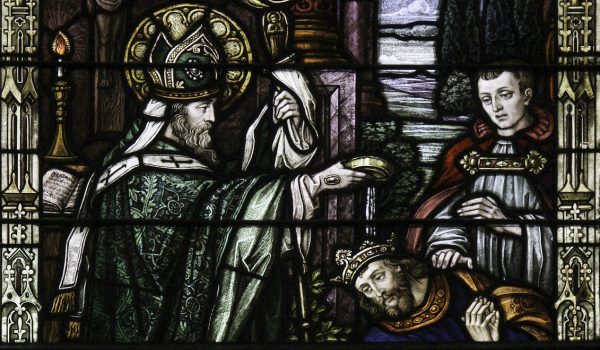“Similar to the Irish people, St. Patrick moved from slavery to slavery. Looking at the life of today’s celebrated saint, we see three modes of slavery which are emblematic of the people he helped save. St. Patrick and his flock have been slaves to humans, sin, and Christ. The life of Patrick shows us the healing and freeing power of grace which removed the yoke of man and sin and replaced them with the sweet yoke of Christ.
The opening words of St. Patrick’s most famous work, Confessio, read:
“I, Patrick, a sinner, very rustic, and the least of all the faithful, and very contemptible in the estimation of most men, had as father a certain man called Calpornius…who was in the town Bannaventa Berniae…where I conceded capture.”
St. Patrick was the son of a deacon and grandson of a priest—priestly celibacy wasn’t unanimous in the 4th century. Despite his family’s religion, Patrick accused himself of ignorance of God and of committing some grave sin which he never named. He blamed himself for his eventual capture and enslavement as he was shipped off to Ireland. As a slave, Patrick became a figure of solidarity for the Irish people, because the Irish have often suffered human oppression.
During the 17th and 18th centuries, many Irish entered into indentured servitude in order to find passage to America. One should not equate or conflate this type of slavery with the chattel slavery coming from Africa; St. Patrick escaped the latter. In lieu of their status as indentured servants, many Irish (among other poor Europeans) labored under the yoke of another human. Similarly, Irish immigrants during the Industrial Revolution met inhospitable conditions in their apartments and factories. While laboring under harsh demands, many Irish prayed to St. Patrick—a man who spent six years in slavery.
Patrick learned to pray to the Father in secret while he endured injustice. The Father gradually freed him from his sin and ignorance while he endured “hunger and nakedness daily.” Those six years of slavery helped him mature from his rambunctious youth. Patrick grew in love and fear of the Lord while learning Christian humility:
“Whoever would be great among you must be your servant, and whoever would be first among you must be your slave.” (Mt 20:26–27)
After learning humility in the midst of oppression, St. Patrick confessed the mercy God showed him:
“The Lord turned His gaze round on my lowliness and took pity on my adolescence and ignorance and kept watch over me before I knew Him…He fortified me and consoled me as a father consoles a son.”
Eventually, the Lord visited Patrick in a mystical way and guided him out of captivity and Ireland. Patrick’s emancipation from slavery and sin encapsulates St. Paul’s words, “So through God you are no longer a slave but a son” (Gal 4:7). He rejoiced in the “glorious liberty of the children of God” (Rm 8:21). The saint praised the Lord for his liberation from man, but he praised God more for the grace that freed him from ignorance and sin. St. Paul’s words describe well Patrick’s conversion:
“But thanks be to God, that you who were once slaves of sin have become obedient from the heart to the standard of teaching to which you were committed, and, having been set free from sin, have become slaves of righteousness.” (Rm 6:17–18)
Patrick was freed from two forms of slavery in order to become a slave of righteousness. Yet, this slavery is different, because it is tied to sonship and friendship. “No longer do I call you servants…but I have called you friends” (Jn 15:15). It is a paradox that one can be the son of God and a friend of Christ, and find freedom in obedience. Patrick’s life testifies to that truth, as he obeyed the Lord’s call and returned to the land of his captivity.
Patrick records a locution of the Irish people calling to him, “We call you, holy boy, that you come and walk farther among us.” Whereas before the Irish forced Patrick to the yoke of human slavery, here they beckon him to take on the yoke of Christ. The impassioned call helped create one of the greatest evangelizers in Church history and helped produce an emerald isle of the faith.
Today, merrymaking and lamentation seem a fitting response to Ireland’s patronal feast day. It’s a day of Masses, prayers, dancing, and, unfortunately, riotous drinking. The latter debauchery flies in the face of St. Patrick’s sanctity; indeed, the green-clad souls pounding green Guinness manifest the pagan world the saint brazenly entered. St. Patrick, a man freed from a twofold slavery, took on the yoke of Christ to liberate such as these still captive to sin. We can even now learn from his words:
“I had come to Irish gentiles to proclaim the Gospel, and to endure indignities from unbelievers…so that I might give up my freeborn status for the advantage of others…for His name.””
“God, my God, omnipotent King, I humbly adore thee.”
—St. Patrick
“For that sun, which we see rising every day, rises at His command…”
—St. Patrick
“I pray to God to give me perseverance and to deign that I be a faithful witness to Him to the end of my life for my God.”
-St. Patrick
Beannachtaí na Féile Pádraig dhuit,
Matthew


